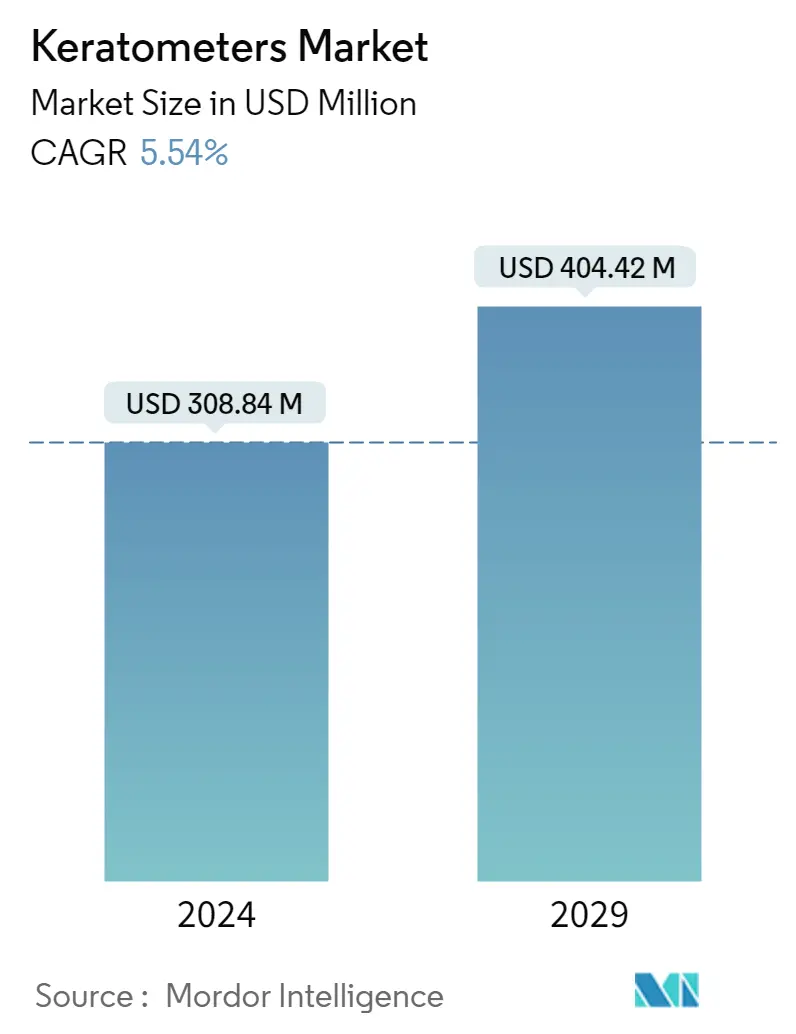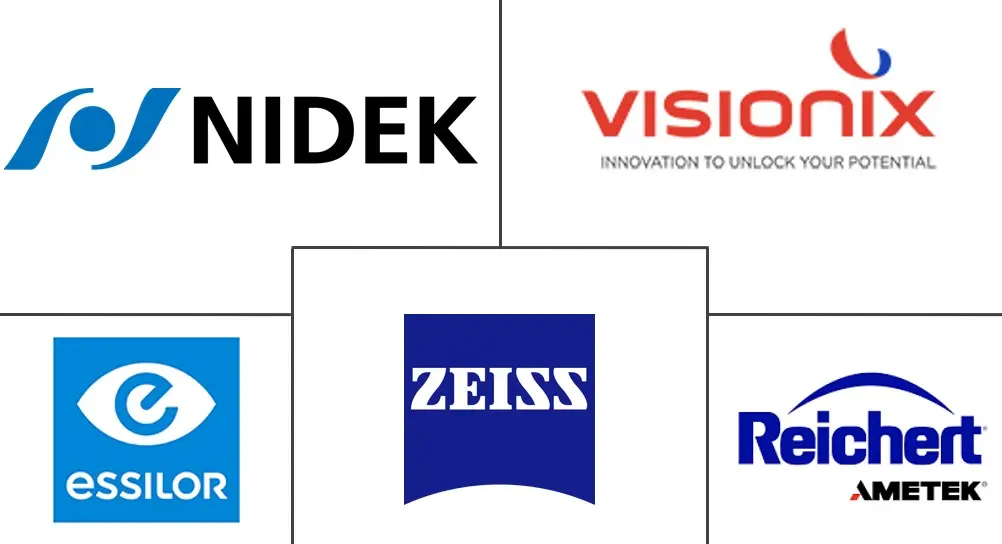Market Size of Keratometers Industry

| Study Period | 2019 - 2029 |
| Market Size (2024) | USD 308.84 Million |
| Market Size (2029) | USD 404.42 Million |
| CAGR (2024 - 2029) | 5.54 % |
| Fastest Growing Market | Asia-Pacific |
| Largest Market | North America |
Major Players
*Disclaimer: Major Players sorted in no particular order |
Keratometers Market Analysis
The Keratometers Market size is estimated at USD 308.84 million in 2024, and is expected to reach USD 404.42 million by 2029, growing at a CAGR of 5.54% during the forecast period (2024-2029).
The COVID-19 pandemic disrupted the treatment and diagnostic activities of diseases other than COVID-19. It impacted the treatment procedures and supply chain of pharmaceuticals and medical devices worldwide, adversely impacting the studied market. For instance, according to the Carl Zeiss annual report 2022, the revenue in the ophthalmic devices strategic business unit (SBU), including keratometers, decreased by -7.3% during the pandemic. However, the revenue from the ophthalmic devices strategic business unit increased by 17% in FY2022. It shows the declined sales revenue of ophthalmic devices like keratometers during the pandemic, which recovered due to a resumed supply chain and diagnostic activities in the healthcare facilities.
The factors driving the market include the increasing burden of eye disorders and growing investments, funds, and grants. The high burden of eye disorders increases the demand for keratometers, which is expected to grow significantly. For instance, as per the report published by InSight Vision Center in December 2021, 23% of infants aged 6 to 12 months would include common astigmatism. Similarly, according to the October 2022 report of the WHO, about 2.2 billion people around the world suffer from near or distant vision impairment, of which approximately 1 billion cases of vision impairment can be prevented. It shows the high burden of the cases of vision impairment. It is expected to include a high demand for the diagnosis using keratometers and likely boost the market over the study period.
Furthermore, the new strategies and initiatives by the market players are expected to significantly impact the market. For instance, in May 2021, ZEISS expanded its national coverage in the United States for its Industrial Quality & Research segment by acquiring Capture 3D. With this acquisition, customers benefitted from a seamless, integrated experience to get the best measuring solutions, and it is expected to propel the market over the stud period.
However, the need for primary infrastructure for eye-related diseases in underdeveloped and developing countries hampers overall market growth.
Keratometers Industry Segmentation
As per the scope, a keratometer (also called an ophthalmometer) is a device used to measure the curvature of the cornea's frontal surface. The Keratometers Market is segmented by type (stationary type keratometers and portable type keratometers), end user (hospitals, eye clinics, and others), and geography (North America, Europe, Asia-Pacific, Middle East, and Africa, and South America). The report also covers the estimated market sizes and trends for 17 countries across major regions globally. The report offers the value (USD) for the above segments.
| By Type | |
| Stationary Type Keratometers | |
| Portable Type Keratometers |
| By End User | |
| Hospitals | |
| Eye Clinics | |
| Others |
| Geography | ||||||||
| ||||||||
| ||||||||
| ||||||||
| ||||||||
|
Keratometers Market Size Summary
The keratometers market is poised for significant growth over the forecast period, driven by the increasing prevalence of eye disorders and the rising demand for diagnostic tools. The market experienced a temporary setback due to the COVID-19 pandemic, which disrupted supply chains and diagnostic activities, leading to a decline in sales. However, the market has since rebounded, supported by resumed healthcare operations and strategic initiatives by key players. The demand for keratometers is expected to rise as the burden of vision impairment continues to grow globally, with a substantial number of individuals affected by conditions such as astigmatism, farsightedness, and nearsightedness. Investments in healthcare infrastructure, particularly in regions like North America and India, are further anticipated to bolster market expansion.
The market landscape is moderately consolidated, with major players like Carl Zeiss AG, Essilor, and NIDEK CO., LTD. actively engaging in strategic mergers, acquisitions, and partnerships to enhance their market positions. These companies are also focusing on research and development to drive innovation in keratometry technology. The North American region is expected to maintain a significant market share, supported by increased research funding and a high prevalence of eye disorders. Additionally, collaborations and new product launches, such as those by EssilorLuxottica and WaveFront Dynamics Inc., are expected to contribute to the market's growth by advancing knowledge and technology in myopia management and keratometry measurements.
Keratometers Market Size - Table of Contents
-
1. MARKET DYNAMICS
-
1.1 Market Overview
-
1.2 Market Drivers
-
1.2.1 Increasing Burden of Eye Disorders
-
1.2.2 Growing Investments, Funds, and Grants on Eye Care Devices
-
-
1.3 Market Restraints
-
1.3.1 Lack of Primary Infrastructure For Eye Related Diseases in Underdeveloped and Developing Countries
-
-
1.4 Porter's Five Forces Analysis
-
1.4.1 Bargaining Power of Suppliers
-
1.4.2 Bargaining Power of Buyers/Consumers
-
1.4.3 Threat of New Entrants
-
1.4.4 Threat of Substitute Products
-
1.4.5 Intensity of Competitive Rivalry
-
-
-
2. MARKET SEGMENTATION (Market Size by Value - USD)
-
2.1 By Type
-
2.1.1 Stationary Type Keratometers
-
2.1.2 Portable Type Keratometers
-
-
2.2 By End User
-
2.2.1 Hospitals
-
2.2.2 Eye Clinics
-
2.2.3 Others
-
-
2.3 Geography
-
2.3.1 North America
-
2.3.1.1 United States
-
2.3.1.2 Canada
-
2.3.1.3 Mexico
-
-
2.3.2 Europe
-
2.3.2.1 Germany
-
2.3.2.2 United Kingdom
-
2.3.2.3 France
-
2.3.2.4 Italy
-
2.3.2.5 Spain
-
2.3.2.6 Rest of Europe
-
-
2.3.3 Asia-Pacific
-
2.3.3.1 China
-
2.3.3.2 Japan
-
2.3.3.3 India
-
2.3.3.4 Australia
-
2.3.3.5 South Korea
-
2.3.3.6 Rest of Asia-Pacific
-
-
2.3.4 Middle East and Africa
-
2.3.4.1 GCC
-
2.3.4.2 South Africa
-
2.3.4.3 Rest of Middle East and Africa
-
-
2.3.5 South America
-
2.3.5.1 Brazil
-
2.3.5.2 Argentina
-
2.3.5.3 Rest of South America
-
-
-
Keratometers Market Size FAQs
How big is the Keratometers Market?
The Keratometers Market size is expected to reach USD 308.84 million in 2024 and grow at a CAGR of 5.54% to reach USD 404.42 million by 2029.
What is the current Keratometers Market size?
In 2024, the Keratometers Market size is expected to reach USD 308.84 million.

